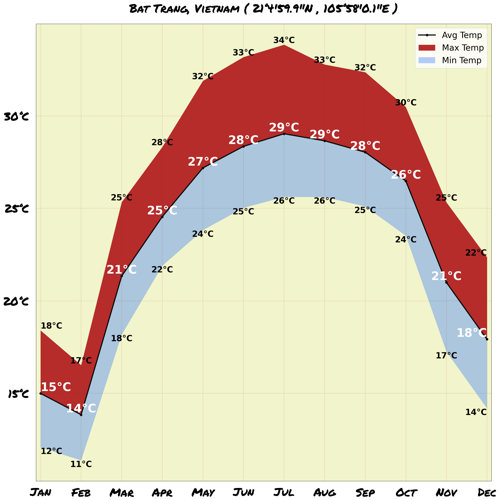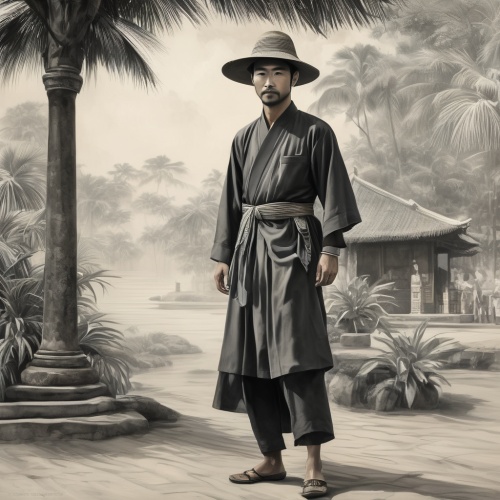Understand
Bat Trang, an ancient ceramic village over 1000 years old, is located approximately 16 km southeast of Hanoi, the capital of Vietnam. The village's history dates back to 1010, when King Ly Thai To moved the capital to Thang Long, making it the political center of the Republic of Vietnam. As Thang Long developed, many merchants and craftsmen migrated to the city for opportunities. Among them were potters from the Bo Bat region, who settled in what is now Bat Trang village. The abundance of white clay in the area made it an ideal location for pottery production. Over time, Bat Trang transformed from a modest pottery village into a renowned center for ceramics, supplying tributes to the Ming Dynasty. During the 15th and 16th centuries, Bat Trang ceramics flourished due to Mac's open business policy. The ceramics were renowned for their intelligent manufacturing, designed for high-ranking officials, nobles, and even princesses. The popularity of Bat Trang ceramics spread across the northern plains and the northern Central Coast. As maritime trade expanded throughout the 16th and 17th centuries, Bat Trang ceramics found their way into Japan and Southeast Asia. The Ming Dynasty's restriction on private foreign trade, along with the policy changes in China and Taiwan, brought new opportunities for Bat Trang, allowing it to thrive. The 18th and 19th centuries witnessed a decline in external trade relations for Vietnam. However, Bat Trang ceramics remained vital, serving as essential household, worship, and decoration items for all classes of society. The village adapted to the changes, continuing its traditional ceramic production by the riverside, with the waterway serving as a gateway to the world. During the French colonial period, Bat Trang faced competition from ceramic enterprises and foreign goods. Despite these challenges, it continued to operate and adapt. Since 1986, Bat Trang has embarked on a journey to become a hub of the market economy. While some cooperatives transformed into joint-stock companies, small-scale production units still thrive. Today, Bat Trang offers an array of products, from traditional ceramic items to new designs fulfilling the demands of domestic and international markets. Its ceramics can be found not only in Vietnam but also in many countries across Asia and Europe.
Map & Climate
Popular Foods
 Phở - Phở is a popular Vietnamese soup consisting of broth, rice noodles, herbs, and meat, typically either beef or chicken. The broth is often made from simmering bones and vegetables, resulting in a rich, savory flavor. Phở is commonly served with side dishes such as lime wedges, bean sprouts, and chili sauces.
Phở - Phở is a popular Vietnamese soup consisting of broth, rice noodles, herbs, and meat, typically either beef or chicken. The broth is often made from simmering bones and vegetables, resulting in a rich, savory flavor. Phở is commonly served with side dishes such as lime wedges, bean sprouts, and chili sauces. Bánh mì - Bánh mì is a Vietnamese sandwich that typically includes a combination of meats, such as pork, ham, and/or chicken, pickled vegetables, and chilies, all served on a crusty baguette. It's a fusion of French and Vietnamese cuisine, reflecting Vietnam's colonial past.
Bánh mì - Bánh mì is a Vietnamese sandwich that typically includes a combination of meats, such as pork, ham, and/or chicken, pickled vegetables, and chilies, all served on a crusty baguette. It's a fusion of French and Vietnamese cuisine, reflecting Vietnam's colonial past. Gà nuòng - Gà nuòng, also known as grilled chicken, is marinated in a mixture of ginger, garlic, fish sauce, sugar, and other seasonings before being cooked over charcoal. The result is a flavorful, tender chicken dish with slightly caramelized edges. It is commonly enjoyed at casual eateries and street food stalls across Vietnam.
Gà nuòng - Gà nuòng, also known as grilled chicken, is marinated in a mixture of ginger, garlic, fish sauce, sugar, and other seasonings before being cooked over charcoal. The result is a flavorful, tender chicken dish with slightly caramelized edges. It is commonly enjoyed at casual eateries and street food stalls across Vietnam.




Comments
NO COMMENTS